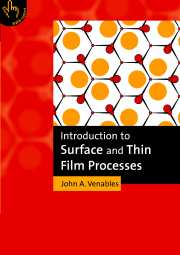Book contents
- Frontmatter
- Contents
- Preface
- Chapter 1 Introduction to surface processes
- Chapter 2 Surfaces in vacuum: ultra-high vacuum techniques and processes
- Chapter 3 Electron-based techniques for examining surface and thin film processes
- Chapter 4 Surface processes in adsorption
- Chapter 5 Surface processes in epitaxial growth
- Chapter 6 Electronic structure and emission processes at metallic surfaces
- Chapter 7 Semiconductor surfaces and interfaces
- Chapter 8 Surface processes in thin film devices
- Chapter 9 Postscript – where do we go from here?
- Appendix A Bibliography
- Appendix B List of acronyms
- Appendix C Units and conversion factors
- Appendix D Resources on the web or CD-ROM
- Appendix E Useful thermodynamic relationships
- Appendix F Conductances and pumping speeds, C and S
- Appendix G Materials for use in ultra-high vacuum
- Appendix H UHV component cleaning procedures
- Appendix J An outline of local density methods
- Appendix K An outline of tight binding models
- References
- Index
Chapter 8 - Surface processes in thin film devices
Published online by Cambridge University Press: 06 July 2010
- Frontmatter
- Contents
- Preface
- Chapter 1 Introduction to surface processes
- Chapter 2 Surfaces in vacuum: ultra-high vacuum techniques and processes
- Chapter 3 Electron-based techniques for examining surface and thin film processes
- Chapter 4 Surface processes in adsorption
- Chapter 5 Surface processes in epitaxial growth
- Chapter 6 Electronic structure and emission processes at metallic surfaces
- Chapter 7 Semiconductor surfaces and interfaces
- Chapter 8 Surface processes in thin film devices
- Chapter 9 Postscript – where do we go from here?
- Appendix A Bibliography
- Appendix B List of acronyms
- Appendix C Units and conversion factors
- Appendix D Resources on the web or CD-ROM
- Appendix E Useful thermodynamic relationships
- Appendix F Conductances and pumping speeds, C and S
- Appendix G Materials for use in ultra-high vacuum
- Appendix H UHV component cleaning procedures
- Appendix J An outline of local density methods
- Appendix K An outline of tight binding models
- References
- Index
Summary
This chapter discusses surface and near-surface processes that are important in the context of the production and use of various types of thin film device. In section 8.1 the role of band bending at semiconductor surfaces is considered along with the importance, and the perfection, of oxide layers and metal contacts on silicon surfaces. Section 8.2 describes models which have been developed to understand electronic and optical devices based on metal–semiconductor and semiconductor–semiconductor interfaces. Then section 8.3 describes conduction processes in both non-magnetic and magnetic materials, and discusses some of the trends which are emerging in new technologies based on thin films with nanometer length scales. The final section 8.4 discusses chemical routes to manufacturing, including novel forms of synthesis and materials development. The treatment in this chapter is rather broad; my aim is to relate the material back to topics discussed in previous chapters, so that, in conjunction with the further reading and references given, emerging technologies may be better understood as they appear.
Metals and oxides in contact with semiconductors
This section covers various models of metals in contact with semiconductors, and the oxide layers on semiconductors. Such topics are important for MOS (metal–oxide–semiconductor) and the widely used CMOS (complementary-MOS) devices. Models in this field have been extremely contentious, so sometimes one has felt that little progress has been made. However, recent developments and some new experimental techniques have shed light on what is happening.
Band bending and rectifying contacts at semiconductor surfaces
Band bending can occur just below free semiconductor surfaces, and when metals or oxides come into contact with semiconductors.
- Type
- Chapter
- Information
- Introduction to Surface and Thin Film Processes , pp. 260 - 296Publisher: Cambridge University PressPrint publication year: 2000
- 2
- Cited by

